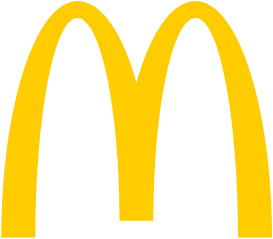Revised as of
10 Sept 2023
Symbols are straightforward as letters, icons, maps, diagrams, universally understood images, and punctuation marks. As opposed to symbolism, which is a literary technique involving more evolved images, ideas, or concepts.
NOTE: Many symbols can fall into multiple categories, but the context and intention helps with understanding how to read them.
Yeahhhh, symbols are NOT limited to punctuation. They are everywhere!!
Consider what comes to your mind when you see:
- An American flag
- A red cross
- $, $$, $$$$$
- A picture of Einstein
- A gun
Thinking of that gun, what do you imagine if that were a Tommy gun, a phaser, an AK-47, a Smith & Wesson? Is there a setting that pops into your head? With the first, I’m thinking Al Capone and Prohibition. The second opens up a range of possibilities from Star Trek to Stargate. An AK is black ops with all those possibilities. As for a Smith & Wesson? I’m thinking a Western or a cop story.
Anywhere you see an image of Einstein or a mention of him, and I’ll bet you’re thinking intelligent or genius.
Using symbols in your writing can be much more complex as “characters, settings, images, or other motifs that stand in for bigger ideas”, giving your “work … more meaning and [making your] story be about more than the events it describes” (Literary Terms).
The Properly Punctuated explores . . .
. . . the proper use of quotation marks, commas, semicolons, colons, ellipsis, etc., including how to properly mark dialog, ahem. As Properly Punctuated is in no way complete, I would appreciate suggestions and comments from anyone on punctuation with which you struggle or on which you can contribute more understanding.
If you found this post on “Symbol” interesting, consider subscribing to KD Did It, if you’d like to track this post for future updates.
| Symbol | |||||||||||||||||||||||||||||||||||
| Part of Speech: Punctuation, Abbreviation | |||||||||||||||||||||||||||||||||||
| Definition: A mark or character used as a conventional representation of an object, function, or process.
|
|||||||||||||||||||||||||||||||||||
| Abbreviation | Definition: A shortened form of a word or phrase. | ||||||||||||||||||||||||||||||||||
| Letter | Definition: A character, a segmental symbol, that is part of an alphabet representing words and sounds. | ||||||||||||||||||||||||||||||||||
|
Return to top or post contents |
|
||||||||||||||||||||||||||||||||||
| Rule: Character(s) standing for a chemical element. | |||||||||||||||||||||||||||||||||||
|
|||||||||||||||||||||||||||||||||||
| Musical Notation | Definition: Symbols that represent aurally perceived music played with instruments or sung by the human voice through the use of written, printed, or otherwise-produced symbols. | ||||||||||||||||||||||||||||||||||
|
Return to top or post contents |
|
||||||||||||||||||||||||||||||||||
| Sign | Definition: Universally understood marks. | ||||||||||||||||||||||||||||||||||
|
Return to top or post contents |
|
||||||||||||||||||||||||||||||||||
| Cartogram | Definition: A nontraditional map/diagram communicates information visually, making it much easier to understand intended messages, emphasizing attributes of interest/ statistical information (total population, age of inhabitants, electoral votes, GDP, etc.) with geographic location with the shape/size reflecting the statistics. | ||||||||||||||||||||||||||||||||||
|
Return to top or post contents |
As a cartogram does not represent geographic space, but alters the size of objects in proportion to an attribute, it is not considered a scaled map, so a cartogram does not always appear visually similar to a map.
A.k.a. anamorphated image, diagrammatic map, spatial transformation, value-by-area map Credit to: Cartogram |
||||||||||||||||||||||||||||||||||
| Area (type) | Definition: Scales the area of a geographic object in proportion to an attribute.
A.k.a. isodemographic map, value-by-area map |
||||||||||||||||||||||||||||||||||
|
Return to top or post contents |
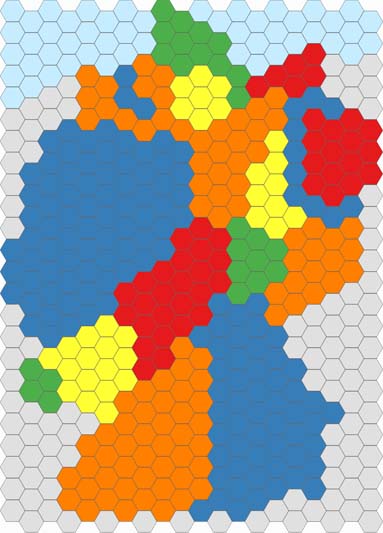
Germany Population States Hexagonal is Crissov‘s own work and is under the CC BY-SA 4.0 license, via Wikimedia Commons. |
||||||||||||||||||||||||||||||||||
| Linear (type) | Definition: Scales the length (distance or travel time) of geographic objects in proportion to the attribute being mapped. | ||||||||||||||||||||||||||||||||||
|
Return to top or post contents |
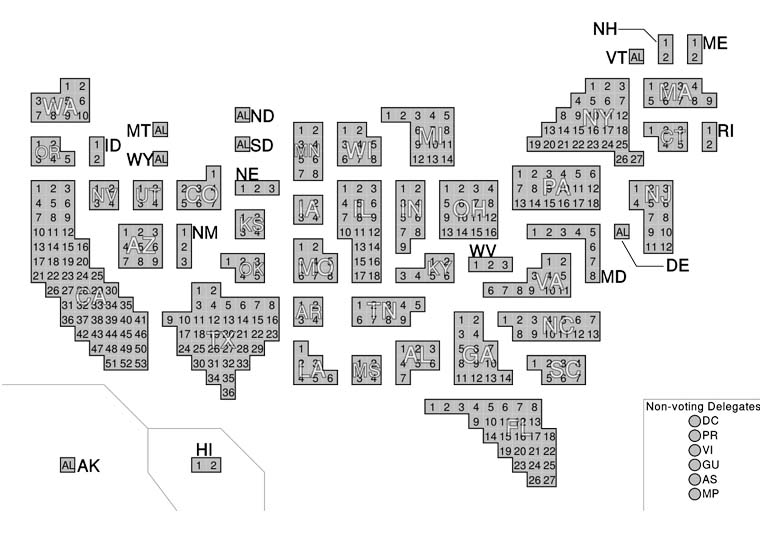
2010 Census Apportionment House Cartogram (Linear) by CX_Zoom is under the CC BY-SA 4.0 license, via Wikimedia Commons. |
||||||||||||||||||||||||||||||||||
| Contiguous (form) | Rule: Forces neighboring objects to remain in contact, resulting in a distortion of shape. | ||||||||||||||||||||||||||||||||||
|
Return to top or post contents |
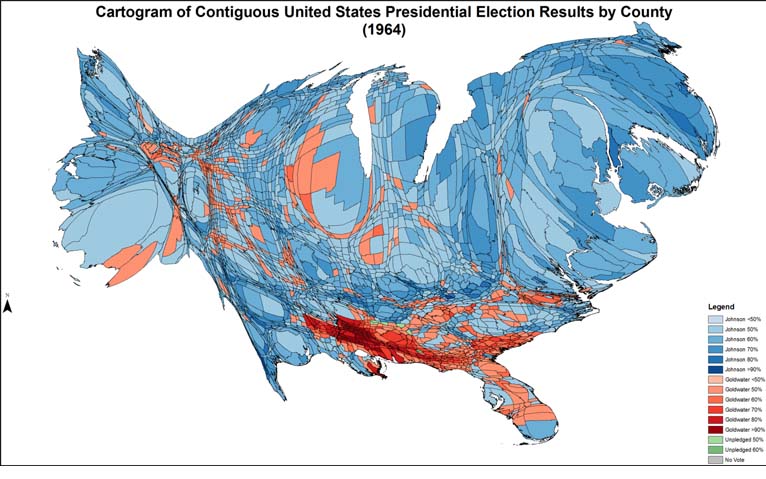
Cartogram: Presidential County, 1964, is a derivative work by Tilden76 courtesy of the Minnesota Population Center, National Historical Geographic Information System: Version 2.0. Minneapolis, MN: University of Minnesota 2011 is under the CC BY-SA 4.0 license, via Wikimedia Commons. — It’s distorted all right, in this contiguous cartogram. |
||||||||||||||||||||||||||||||||||
| Noncontiguous (form) | Rule: Allows the geographic objects to be detached from their adjacent neighbors, permitting the objects to expand or contract their area without distorting their natural shape. | ||||||||||||||||||||||||||||||||||
|
Return to top or post contents |
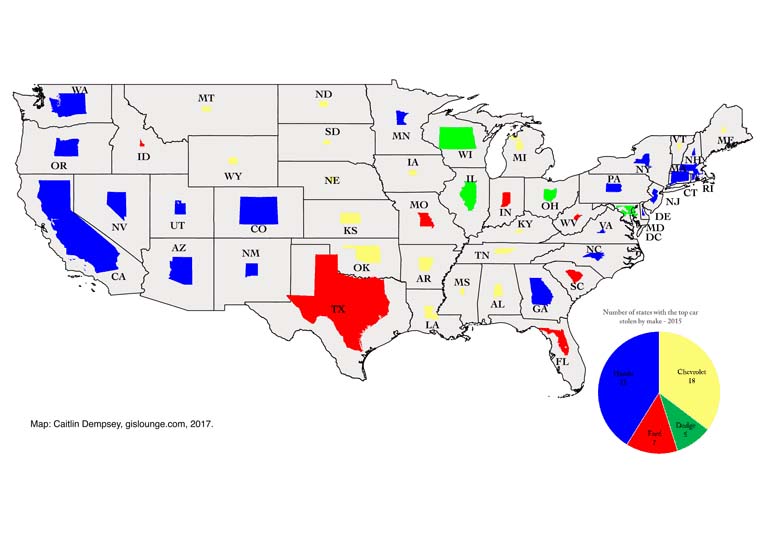
How to Create a Non-contiguous Cartogram Using QGIS by Caitlin Dempsey, 15 Feb 2017, courtesy of gislounge.com. |
||||||||||||||||||||||||||||||||||
| Dorling (form) | Rule: Geographic objects are replaced with a uniform non-overlapping shape, such as a circle, where the area of the circle is proportional to the attribute being represented. | ||||||||||||||||||||||||||||||||||
|
Return to top or post contents |

Cartogram-2004 Electoral Vote is ChrisnHouston‘s own work is under the CC BY-SA 3.0 license, via Wikimedia Commons. — An example of a Dorling cartogram. |
||||||||||||||||||||||||||||||||||
| Pseudo (form) | Rule: Looks like a cartogram but does not follow certain cartogram rules, which can create extensive error in the actual size of the objects.
A.k.a. false cartogram Credit to: Cartogram Types. |
||||||||||||||||||||||||||||||||||
|
Return to top or post contents |
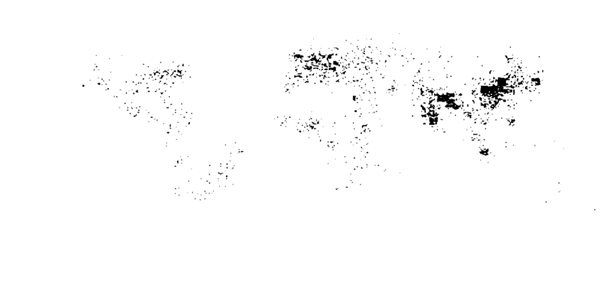
Credit to: Tobler |
||||||||||||||||||||||||||||||||||
| Diagram | Definition: A functional representation of information using visualization techniques, illustrating a sequence of facts or functions. | ||||||||||||||||||||||||||||||||||
|
Return to top or post contents |
Charts, including tree diagram, network diagram, flowchart, Venn diagram, or existential graph
Graphs, including histogram, bar graph, pie chart, function graph, scatter plot Schematics, including train schedule diagram, exploded view, population density map, Pioneer plaque, three-dimensional diagram And so many more |
||||||||||||||||||||||||||||||||||
| Iconogram | Definition: Symbols, pictures, and objects that represent the ideas and way of life of a culture or a religion, describing a large idea in a very short manner.
A subset may examine an artist’s use of an imagery in a particular work. |
||||||||||||||||||||||||||||||||||
|
Return to top or post contents |
|
||||||||||||||||||||||||||||||||||
| Ideogram | Definition: A graphical symbol that represents an idea or concept.
A.k.a. ideograph |
||||||||||||||||||||||||||||||||||
|
Return to top or post contents |
|
||||||||||||||||||||||||||||||||||
| Emoji | Definition: An actual image used in electronic communications that is meant to communicate the emotional state of the author.
They are extensions to the Unicode character set. A.k.a. emote |
||||||||||||||||||||||||||||||||||
|
Return to top or post contents |
|
||||||||||||||||||||||||||||||||||
| Emoticon | Definition: A display built from keyboard characters of a facial representation, used to convey emotion in a text-only medium.
They are built from ASCII. A.k.a. emotion icon |
||||||||||||||||||||||||||||||||||
|
Return to top or post contents |
|
||||||||||||||||||||||||||||||||||
| Logogram | Definition: A symbol that stands for an individual word or phrase.
You may want to explore the Grammar Explanation post “Logogram“. |
||||||||||||||||||||||||||||||||||
|
Return to top or post contents |
|
||||||||||||||||||||||||||||||||||
| Phonogram | Definition: A letter or combination of letters that represent a sound. | ||||||||||||||||||||||||||||||||||
|
Return to top or post contents |
|
||||||||||||||||||||||||||||||||||
| Pictogram | Definition: A symbol that conveys meaning through its resemblance to a physical object. Very useful in an environment where many people may not be familiar with the language of the place they are in.
A.k.a. icon, pictograph |
||||||||||||||||||||||||||||||||||
|
Return to top or post contents |
|
||||||||||||||||||||||||||||||||||
| Punctuation Mark | Definition: Symbols used to aid the clarity and comprehension of written language. | ||||||||||||||||||||||||||||||||||
(Linked entries take you to a post. Indicates the hexadecimal code.)
You may also want to explore the post “Dialogue” for details on punctuating your character’s communication, Comma and the Vocative Case” could be considered part of dialogue, “When Quotes = Sarcasm“, or using parentheses as an “Interrupter“. |
|||||||||||||||||||||||||||||||||||
| Typogram | Definition: Expresses the meaning of that word by changing the position, size, and arrangement of the letters. | ||||||||||||||||||||||||||||||||||
|
Return to top or post contents |
m•ss•ng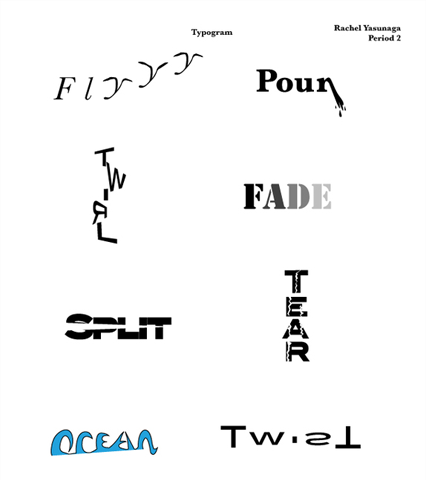
Credit to: Yasunaga |
||||||||||||||||||||||||||||||||||
C’mon, get it out of your system, bitch, whine, moan . . . which words are your pet peeves? Also, please note that I try to be as accurate as I can, but mistakes happen or I miss something. Email me if you find errors, so I can fix them . . . and we’ll all benefit!
Satisfy your curiosity about other Properly Punctuated posts on its homepage or more generally explore the index of self-editing posts. You may also want to explore Book Layout & Formatting Ideas, Formatting Tips, Grammar Explanations, Linguistics, Publishing Tips, Word Confusions, Writing Ideas and Resources, and Working Your Website.
Resources for Symbol
“Cartogram.” Geography. n.d. Web. 15 March 2020. <https://geography.name/cartogram/>.
“Cartogram Types.” <http://www.ncgia.ucsb.edu/projects/Cartogram_Central/types.html>.
Kunstler, Julianna. “SYMBOLS in Visual Communication.” <https://juliannakunstler.com/vislit_symbols.html>.
Lile, Samantha. “40 Visual Symbols Every Communicator Needs to Know.” Visme. n.d. Web. 15 March 2020. <https://visme.co/blog/symbols-and-meanings/>.
“Symbol.” Literary Terms. n.d. Web. 13 March 2020. <https://literaryterms.net/symbol/>.
Tobler, Waldo. “Pseudo-Cartograms. Cartography and Geographic Information Science” – CARTOGR GEOGR INF SCI. 13. 43-50. 10.1559/152304086783900194. 1986. Web. 16 March 2020. <https://www.researchgate.net/figure/Pseudo-cartogram-of-the-United-States-obtained-from-population-data-given-by-one-degree_fig1_240764741>.
Walker, Jarrett. “Redistorting Maps: The Virtue of Cartograms.” Human Transit. 5 January 2012. Web. 15 March 2020. <https://humantransit.org/2012/01/redistorting-maps.html>.
Yasunaga, Rachel. A typogram assignment created in an ACCP typography class at Mililani High School, <https://mhsaccp.weebly.com/typogram.html>.
Zhu, Benjamin. “How to Create an Area Cartogram in Shapefile Format.” StackExchange. 29 March 2019. Web. 15 March 2020. <https://gis.stackexchange.com/questions/317187/how-to-create-an-area-cartogram-in-shapefile-format>.
Pinterest Photo Credits:
California Typography in Black is in the public domain, via Free*SVG.















